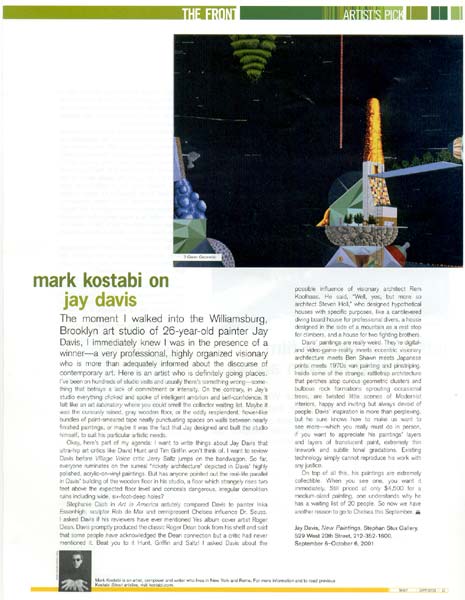Mark Kostabi on Jay Davis

The moment I walked into the Williamsburg, Brooklyn art studio of 26-year-old painter Jay Davis, I immediately knew I was in the presence of a winner- a very professional, highly organized visionary who is more than adequately informed about the discourse of contemporary art. Here is an artist who is definitely going places. I’ve been on hundreds of studio visits and usually there’s something wrong-something that betrays a lack of commitment or intensity. On the contrary, in Jay’s studio everything clicked and spoke of intelligent ambition and self-confidence. It felt like an art laboratory where you could smell the collector waiting list. Maybe it was the curiously raised gray wooden floor, or the oddly resplendent, flower-like bundles of paint-smeared tape neatly punctuating spaces on walls between nearly finished paintings, or maybe it was the fact that Jay designed and built the studio himself, to suit his particular artistic needs.
Okay, here’s part of my agenda: I want to write things about Jay Davis that ultra-hip art critics like David Hunt and Tim Griffin won’t think of. I want to review Davis before Village Voice critic Jerry Saltz jumps on the bandwagon. So far, everyone ruminates on the surreal “rickety architecture” depicted in Davis’ highly polished, acrylic-on-vinyl paintings. But has anyone pointed out the real-life parallel in Davis’ building of the wooden floor in his studio, a floor which strangely rises two feet above the expected floor level and conceals dangerous, irregular demolition ruins including wide, six-foot-deep holes?
Stephanie Cash in Art in America astutely compared Davis to painter Inka Essenhigh, sculptor Rob de Mar and omnipresent Chelsea influence Dr. Seuss. I asked Davis if his reviewers have ever mentioned Yes album cover artist Roger Dean. Davis promptly produced the classic Roger Dean book from his shelf and said that some people have acknowledged the Dean connection but a critic had never mentioned it. Beat you to it Hunt, Griffin and Saltz! I asked Davis about the possible influence of visionary architect Rem Koolhaas. He said, “Well, yes, but more so architect Steven Holl,” who designed hypothetical houses with specific purposes, like a cantilevered diving board house for professional divers, a house designed in the side of a mountain as a rest stop for climbers, and a house for two fighting brothers.
Davis’ paintings are really weird. They’re digital- and video-game-reality meets eccentric visionary architecture meets Ben Shawn meets Japanese prints meets 1970s van painting and pinstriping. Inside some of the strange, rattletrap architecture that perches atop curious geometric clusters and bulbous rock formations sprouting occasional trees, are twisted little scenes of Modernist interiors, happy and inviting but always devoid of people. Davis’ inspiration is more than perplexing, but he sure knows how to make us want to see more-which you really must do in person, if you want to appreciate his paintings’ layers and layers of translucent paint, extremely thin linework and subtle tonal gradations. Existing technology simply cannot reproduce his work with any justice.
October 2001